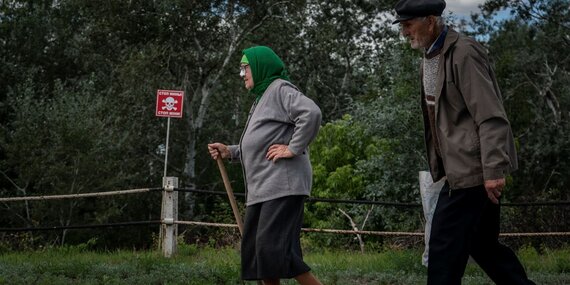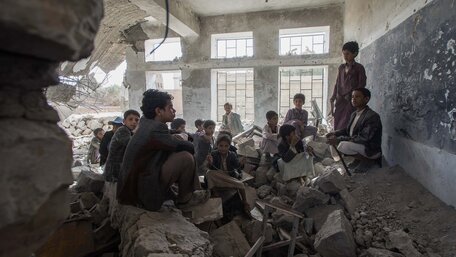Ukraine
An elderly couple pass by a minefield sign in eastern Ukraine. OCHA/Yevhen Maloletka
Humanitarian needs arising from armed conflict in eastern Ukraine remain critical, exacerbated by the continuing impact of COVID-19. Living conditions continue to deteriorate on both sides of the “contact line”, the 427 km front line that divides eastern Ukraine into areas under Government control (GCA) and beyond Government control (NGCA). Restrictions on movement across the “contact line” widen the rift between the now-divided population, severing previously interdependent networks of services and markets, and cutting people off from the cities they once depended on for social benefits and essential services.
Now in its eighth year, the protracted armed conflict has faded from global headlines, causing mistaken perceptions that it is “frozen”. People living in the conflict-affected oblasts risk falling victim to active hostilities, as the ceasefire brokered in July 2020 has become increasingly fragile. The number of civilian casualties has returned to pre-ceasefire levels, and civilian objects, including housing, schools, health facilities, and electrical and water infrastructure, frequently come under fire. Widespread contamination by unexploded ordnance and mines remains a serious concern and is responsible for nearly 70 per cent of civilian casualties during the 14 months following the ceasefire. Eastern Ukraine has become one of the most mine-contaminated areas in the world, ranking fifth worldwide for casualties due to landmines and other explosive remnants of war.
Ukraine
Analysis of the context, crisis and needs
The socioeconomic impact of COVID-19 in eastern Ukraine has become increasingly pronounced due to the prolonged closure of the “contact line”, movement restrictions and decreasing livelihood opportunities. Access to essential services has been severely hindered, particularly across the “contact line” in NGCA. The shock of COVID-19 has added pressure on the weakened health-care system, while the provision of social services has struggled.
An estimated 2.9 million people are projected to need humanitarian assistance in 2022, with the majority living in NGCA. The severity of needs is lower in GCA, particularly in the areas farther away from the “contact line”, leading to a lower number of people who need humanitarian assistance there, partly due to the support provided by the Government of Ukraine, civil society and development actors. Severe humanitarian needs remain in areas close to the “contact line” where active hostilities continue. Older people, people with disabilities, female-headed households and children living in isolated villages are particularly vulnerable due to their limited mobility and economic challenges.

Zhovanka, Ukraine
A 66-year-old man stands inside the house he had built for his children that was largely destroyed due to active hostilities in the Donetska oblast.
OCHA/Yevhen MaloletkaHumanitarian needs in NGCA remain severe and continue to deteriorate. NGCA residents have been most impacted by COVID-19-related movement restrictions across the “contact line” imposed since March 2020. The restrictions have separated a population with a significant proportion of underemployed and older persons from the rest of Ukraine, cutting them off from social services and entitlements, including pensions, which they can access only once physically present in GCA. With only two of the five crossing points partially operational, the number of people crossing the “contact line” has dropped precipitously. Monthly crossings are averaging less than 7 per cent of the 1.2 million monthly crossings in 2019. The limited opportunities for crossing the “contact line” have forced some NGCA residents to travel to GCA through the Russian Federation – an expensive journey that can take more than 24 hours. The resilience of the most vulnerable people on both sides of the “contact line” has been worn thin, leading to greater reliance on humanitarian assistance.
Projected situation in 2022 and beyond
Amid the increasingly fragile ceasefire, it is likely that the armed conflict will continue with low or medium intensity in 2022. With the harsh winter fast approaching and a worsening COVID-19 epidemiological situation – which is reported to be especially acute in NGCA due to the limited capacity of hospitals and laboratories – the operational environment has become increasingly complicated. As the winter season draws closer, Ukraine faces an energy crisis on multiple fronts which could lead to political instability. The conflict continues to be extremely politicized, and underfunding and persistent access constraints remain serious challenges to humanitarian operations in eastern Ukraine. COVID-19 continues to be used as an excuse to justify a greater level of control over humanitarian projects and aid delivery, limiting humanitarian access to people in need.

Sievierodonetsk, Ukraine
A nurse checks on an older man infected with COVID-19 in a clinic in Sievierodonetsk, Luhanska oblast.
OCHA/Yevhen MaloletkaThe “contact line” will likely remain mostly closed throughout 2022, continuing to restrict the population’s free movement. The severity of humanitarian needs, especially in NGCA, is expected to deepen due to ongoing hostilities, insufficient investment in civilian services infrastructure and the impact of COVID-19. The politicization of humanitarian issues and the lack of progress on peace talks will likely result in less conducive operational conditions for humanitarian response.
Response priorities in 2022
The 2022 response will focus on saving lives, ensuring people’s access to basic services, and strengthening protection to those affected by the conflict and COVID-19. In GCA, humanitarian actors will continue to support the Government, local authorities and civil society to strengthen service delivery and provide humanitarian response, with the goal of phasing out international humanitarian assistance in GCA by the end of 2023.
Ukraine HRP
This goal recognizes the strong capacity, particularly of the regional and local authorities, the development opportunities that are present and the progress made on the humanitarian-development-peace collaboration. In 2022, humanitarian partners aim to assist 1.8 million people (including 144,000 internally displaced persons), similar to the response target of 2021, with a funding requirement of US$190 million.
Further reading
Source: OCHA
Source: Humanitarian Insight
Source: Financial Tracking Service





